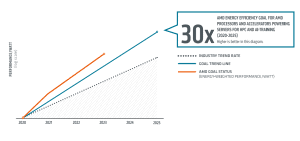Advanced Micro Devices (AMD) surpassed Q2 sales forecasts, reporting a significant revenue boost. While its data center revenue surged, AMD is also striving for ambitious climate goals and carbon footprint reductions. As the company grows, can its sustainability efforts keep up with its technological advancements and market success?
AMD Beats Q2 Sales Estimates, Data Center Revenue Soars
AMD exceeded analysts’ sales expectations for Q2, with revenue hitting $5.8 billion, a 9% increase from the previous year. Despite net income falling short at $265 million or 16 cents per share, adjusted earnings of 69 cents per share surpassed forecasts.
Data center revenue more than doubled to $2.8 billion, driven by surging demand for AI chips. CEO Lisa Su highlighted growth opportunities from advances in generative AI. AMD projects $6.7 billion in Q3 sales and expects strong revenue growth.
The chipmaker’s shares surged over 7% to $138.44 in after-hours trading following the earnings report.
AMD’s Climate Commitment and Strategies for Net Zero
Advanced Micro Devices has set a robust target to achieve net zero by 2050. This ambitious commitment reflects AMD’s dedication to reducing its carbon footprint and addressing climate change through a multifaceted approach that includes improving energy efficiency, sourcing renewable energy, and investing in supply chain emission management.
Reducing Carbon Emissions
In 2021, AMD established a new science-based target aligned with a 1.5°C scenario: a 50% absolute reduction in greenhouse gas (GHG) emissions from its operations (Scope 1 and 2) by 2030, using 2020 as the base year. This target builds on AMD’s previous successes in reducing its emissions and underscores the company’s commitment to further emissions reductions.
Following the acquisition of Xilinx and Pensando in 2022, AMD recalculated its baseline energy use and GHG emissions to include the combined company’s footprint. The revised 2020 baseline for energy use increased from 123 GWh to 199 GWh, and operating emissions rose from 30,009 to 61,754 metric tons of CO2 equivalent.
Despite this adjustment, AMD achieved a 19% reduction in operating emissions compared to the revised baseline in 2022.

Energy Efficiency and Renewable Energy
Energy efficiency is a cornerstone of AMD’s strategy to slash its carbon footprint. The company has made significant strides in improving the efficiency of its products and operations.
Moreover, AMD has increased its sourcing of renewable energy, with 66 GWh sourced in 2022, accounting for about 32% of its total global energy use, compared to 18% in the revised 2020 baseline. This renewable energy is enough to power approximately 9,275 homes in the U.S. for a year.
At its San Jose campus, AMD has implemented on-site solar generation, including a 1.4 MW solar system with 3,600 panels and a 600 kW rooftop solar installation. This setup includes a 1 MWh battery storage system that stores excess energy for later use and can send surplus energy back to the local power grid.
Environmental Impact and Achievements
Progress Towards Goals
AMD’s environmental goals include a 50% reduction in absolute GHG emissions from operations by 2030 and a 30-fold increase in energy efficiency for processors and accelerators used in AI training and high-performance computing by 2025.
As of mid-2023, AMD is on track for a 13.5-fold improvement in energy efficiency for accelerated compute nodes from the 2020 baseline.
Additionally, AMD aims to have 100% of its direct manufacturing suppliers set public emissions reduction goals by 2025. As of 2022, 70% of these suppliers had such goals. AMD also targets having 80% of its direct manufacturing suppliers source renewable energy by 2025, with 68% already meeting this criterion in 2022.

Operational Efficiency
AMD operates over 90 locations worldwide, including engineering facilities, sales sites, and corporate offices. The company is committed to applying rigorous environmental standards across its operations. AMD’s Global Environmental, Health, and Safety (EHS) Standards align with ISO 14001, a widely recognized standard for environmental management. Notably, AMD’s San Jose and Singapore sites are ISO 14001 certified.
In 2022, AMD implemented approximately 20 energy conservation projects, including equipment upgrades that saved about 1.4 million kWh of electricity. These efforts reflect AMD’s commitment to reducing energy use and GHG emissions across its operations.
Addressing Supply Chain Carbon Emissions
AMD’s supply chain, particularly silicon wafer manufacturing, is a significant source of its GHG emissions. In 2022, direct foundry suppliers reduced their Scope 1 and 2 emissions by about 9% compared to 2020, though absolute emissions increased due to the higher energy demands of more advanced technology nodes.
AMD aims to double the renewable energy use of its primary foundry manufacturing suppliers from 2020 to 2025. The company is also focused on forecasting and mitigating GHG emissions in its supply chain, particularly in Taiwan, where most AMD wafers are manufactured. AMD is actively participating in the SEMI Climate Consortium to promote renewable energy infrastructure in the region.
AMD’s commitment to net zero is backed by a comprehensive strategy that emphasizes energy efficiency, renewable energy, and robust supply chain management. By setting science-based targets, AMD is making significant strides toward reducing its carbon footprint and supporting global climate goals.


